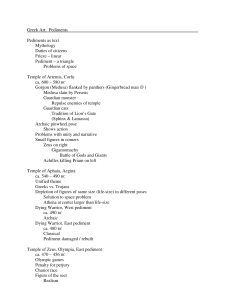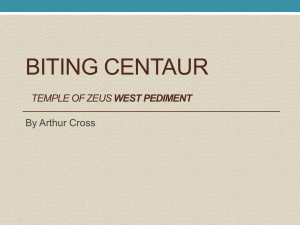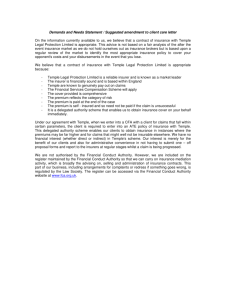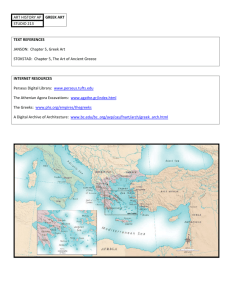View/Open
advertisement
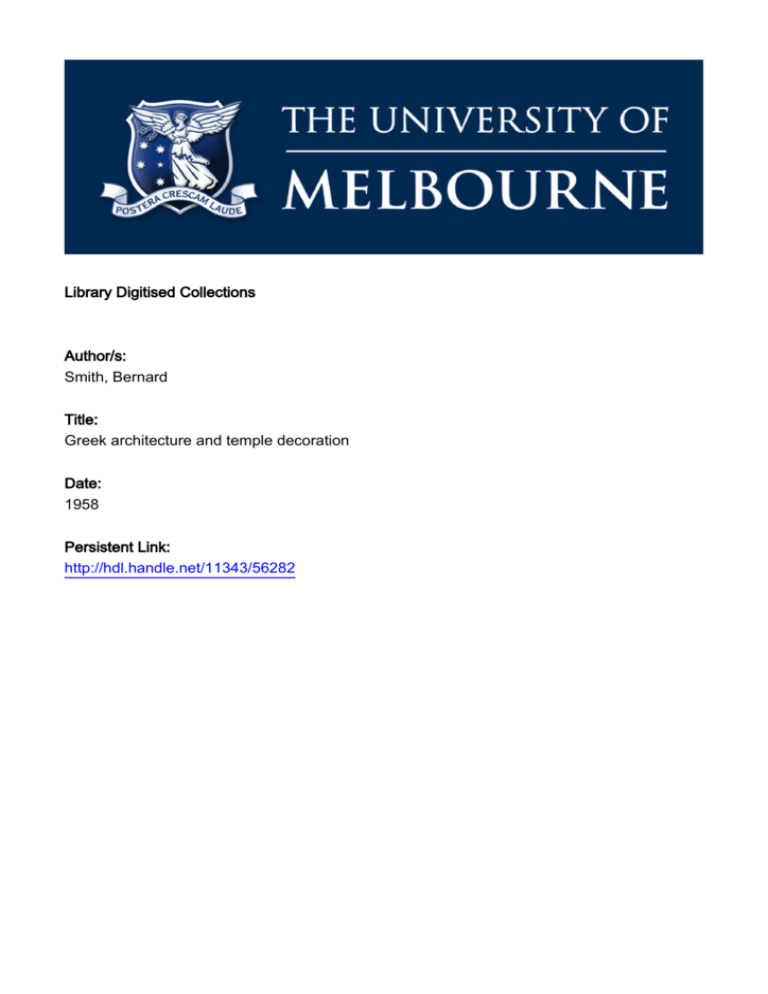
Library Digitised Collections Author/s: Smith, Bernard Title: Greek architecture and temple decoration Date: 1958 Persistent Link: http://hdl.handle.net/11343/56282 Greek Architecture and Temple Decoration 21 April 1958 This morning we shall begin the study of Greek architecture and temple decoration Neither the Minoans nor the Mycenaeans of the Bronze Age made a practice of building temples. They used caves or mountain shrines or fitted up one or two rooms in a palace for the worship of their gods. But for the Greeks, temples were important, not as places of worship, but as shrines for the deity The early temples of the Geometric and Orientalizing periods, that is, from the 10th century down to about 600 B.C., were very simple structures, consisting of timber and sun-dried brick Several shapes were at first used but the rectangular temple, which enclosed a cult statue of the god or goddess in its cella, soon became the dominant type. A porch was often added before the entrance, the porch being supported simply by extending the side walls, or by using a few timber posts. Sometimes the eaves of the temple were increased to for a veranda around the whole building, the roof being supported by wood posts or pillars. The verandas served to protect the walls from sun and rain, and also provided shelter. Colonnades were of course widely used by the Egyptians as internal roof supports and the Minoans made use of the colonnaded courtyard, a practice also much used by the Greeks in their market places and gymnasia. A gymnasium, for instance frequently consisted of a colonnaded courtyard which led off to rooms arranged around a square or rectangle. But in the Greek temple the colonnade becomes and important external feature. In our first slide* we may trace the development of the plan of the Greek temple. One of the simplest forms uses a central cella for the cult statue, with the lateral walls extended and two central columns to support the extension of the roof. Both side walls were terminated by a pilaster which was called in anta, and the front columns were said to be in antis. In the second example the porch is no longer supported by lateral walls but entirely by the four porch columns: this style is known as prostyle. And when another porch of similar style was added at the other end, as they often were, apparently with no other intention than to serve the Greek passion for symmetry, the temple was called amphiprostyle. When a colonnade is added around the four walls we have a periptyral temple; when there is a double row all around, a dipteral temple. Temples are also classified according to the number of columns used in the front of the building: here, with two, a distyle temple, here with four, a tetrastyle, with eight, octastyle. So number 1 is distyle in antis, number 2 is prostyle tetrastyle, number 3 peripteral hexastyle, number 4 dipteral octastyle. The Parthenon, then, is octastyle. For over three hundred years the Greeks built their temples with timber and sun dried brick, and then in the last quarter of the seventh century they began to build in stone. With centuries of timber and clay building behind them they modelled their new stone buildings upon the shapes of the earlier buildings. The Doric temple has been described as petrified carpentry. The Greeks however, with their great passion for mathematics, symmetry and proportion, continually experimented with the relation of one part of the building with another; and these were eventually codified into orders by the Romans. There were two main Greek orders: the Doric and the Ionic. A third order, the so-called Corinthian order differed from the Ionic only in the difference of its capital. Let us turn in our next slide to the main elements of the Doric Order. The foundations of the temple were made of roughly dressed masonry, levelled out at the top, upon which a platform, usually erected in three steps was placed. This was called the stylebate: the two lower steps are sometimes called the stereobate. From the late sixth century onwards the surface of the stylobate slopes gently from the centre of the temple to the sides; adopted initially to remove rain water, the curve was later found to possess an aesthetic significance. The Doric column springs directly from the stylobate. It was composed of superimposed drums of stone. The fluting or grooves cut in the columns were executed after the column had been erected. The standard number of flutes was 20. Fluting had first been used by the Egyptians, and by the Minoans, and the Mycenaeans occasionally, on wooden columns. It has been suggested that the flutes may have derived from the practice of using an adze with a rounded blade to cut off the bark and rough exterior wood of a wooden column. Fluting, too, was found to provide an important visual effect by emphasizing he vertical lines of the column and building, and of distinguishing the column from the masonry behind. The shaft of the Doric column tapers from the bottom upwards: and usually possesses a delicate curve known as the entasis. The reason for his curve is still a matter of debate. Vitruvius, the Roman who wrote the oldest book on architecture that has come down to us, said that these optical refinements were based on the desire to correct optical illusion—and he was using the work of Greek architects of the third and fourth centuries BC. The capital was divided into two members, a curved cushion-like shape called the echinus (after the shape of the sea-urchin), and a square abacus above. The whole area supported by the colonnade is called the entablature. It is divided into three main parts: the architrave, or beam which extends from column to column, the frieze, which in the Doric Order consists of alternating triglyphs and metopes. The triglyphs are thick blocks, whose height exceeds their width, divided into vertical bands by two complete and two half groves. The metopes were stone blocks, either plain or carrying sculpture, between the triglyphs (approximately square). There was normally one triglyph above each column and one centred between each column. The corners however were always terminated by triglyphs, which necessitated the end ones being shifted to the ends Above the frieze is the cornice, heavy stone blocks which form the eaves of the temple. At the end of the temple, there is a raking cornice as well, the area between the raking cornice and the [flat] cornice is called the pediment. Ornaments, known as [acroteria], in terracotta were often fixed at the crown of the pediment and at the corners. The Ionic order developed in Asia Minor and the islands of the Aegean. Unlike the Doric, the column is set on a moulded base, and has usually 24 flutes which are separated by fillets, that is, flat surfaces, not by the sharp edges, or arisas, as in Doric. It is more slender in its proportions than the Doric. The capital consists of a pair of volutes, or spirals. The ionic entablature consists of an architrave, in three planes like superimposed beams, a frieze which was sometimes plain and sometimes ornamented by means of a continuous band of sculpture, and a cornice whose decoration and detail differed in some respects from the Greek cornice. Here in our next slide is an example of a typical Doric Temple, the Temple of Neptune a Paestum, and here, an Ionic temple, the Erechtheon in the Acropolis. Now it will be see from these slides that the dominant lines of a Greek temple are * predominantly vertical (columns, flutings, and triglyphs) and horizontal (steps, entablature and cornice). Sculpture was introduced to provide some diversity from this vertical-horizontal system. In the Doric temple sculpture was * was often placed in the pediment, an overhanging gable at both ends of the temple; in the metopes, the spaces between the triglyphs, in the acroteria, which stood at each corner of the temple, and the antefixes, or water spouts, which were ranged along the cornices on the sides of the temple. In the Ionic order the frieze consisted often of a band of continuous sculpture, instead of the alternating triglyph and metope. All sculpture was originally brightly coloured, especially in blue and red, and must have afforded a cheerful contrast to the brilliant white marble of the temples themselves. I want to turn now to a brief consideration of the development of Greek pedimental and metope sculpture. Before doing so, however, it is necessary to stress one of the characteristic qualities of the Greek genius. The Greeks worked out their artistic problems within a quite narrow range of types; and sought perfection in each type. In architecture for example, there is the Doric Temple, the fundamental plan of which altered very little. The Greeks continually experimented to obtain the most perfect relationship of parts to part ad parts to the whole. In the end they produced the Parthenon. It is the same with the 3-dimensional sculpture: within these simple standing figure types, the kouros and the Kore, the great problems of rendering the human figure naturalistically were solved. And it is the same with their architectural sculpture. The shape of the pediment created peculiar difficulties.* In order to achieve a successful composition in such a space it was necessary first, to place a prominent group in the centre which would provide the chief accent, second to fill the awkward angles at the extremities, thirdly, to compose figures of gradually diminishing heights of the intervening spaces, and lastly, to relate the whole composition into one harmonious effect. In the 100 years before the end of the Persian wars, that is, between 580and 480 the Greeks steadily worked out their problem. In the temple of Artemis at Corfu, circa 580, a colossal kneeling Gorgon was placed at the centre of the pediment. Gorgons were carved on shields, breastplates and amulets, and were considered to be a protection against all forms of evil. Here in the centre of the pediment, the purpose of the Gorgon was probably to ward off evil from the shrine of the Goddess. Only parts of the pediment have been preserved, but our next slide* provides a reconstruction. To the left of the Gorgon, is her son, Chrysaor,* and to the right, her other child, the winged horse Pegasus. On either side of this central motif,* two crouching panthers were placed, heraldically disposed. They probably served like the Gorgon herself to protect the temple although it has been suggested that they represent one of the manifestations of the goddess Artemis, who was considered to be among other things, a tamer of wild beasts. Notice how well.* n our next slide, the crouching panther fits the sloping sides of the pediment, Partly because of their shape, crouching and fight animals were much sed in archaic pediments.* On one of the wings we see Zeus attacking a giant with a thunderbolt, and on the other an old man being stabbed by a warrior. It is suggested that the group represents Priam, king of Troy, being killed by Neoptolemus. Two prone bearded figures, whose heads are rather awkwardly placed in the corners, complete the composition. The pediment of Corfu is interesting therefore bot in imagery and style. The Gorgon and animals have a magical significant; but as opposed to this we see the use of both mythology, as revealed by the Zeus and giant group, and the epic deeds of heroes, in the Priam group, being used as well. The Corfu composition, however despite a magnificent central motif, is awkward. The motifs are disconnected, there is a lack of concerted action, and the figures differ greatly in size. [Our next group of pedimental sculptures are the Poros pediments—a number of limestone pediments, circa 570-550, found on the Acropolis. They belong to temples which stood there until they were destroyed for a rebuilding programme after the Persian wars. Here in our next slide is the Lion Pediment, in which two lions are heraldically disposed. They may be compared to the panthers at Corfu: but their eyes are turned frontally towards the on-comer, like the Corfu Gorgon, and like her they were doubtless intended to guard the temple from evil. The corners were filled with serpents, whose long tails accommodated themselves nicely to the shape of the pediment.] Our second group of pedimental sculptures are the so-called Porous Pediments—a number of archaic limestone or porous pediments from the Acropolis have been preserved which continue the story of pediment composition. In the near front pediment of the first Hecatompedon two lions, heraldically disposed occupy the centre, with snakes in the wings. The rear pediment, which we see in our next slide shows one devouring a bull, and on either side, two scenes from mythology, Herakles struggling with a triton on one side, and on the other, a three-headed sea god, possibly Proteus. The system here combining animal motifs and scenes from mythology is still very much like that at Corfu. When we look, in hour next two slides, at these mythological scenes, first of Herakles, and then of Proteus, one is immediately aware of a greater interest in action, and a greater sense of vitality. Here we have again the use of monsters whose bodies would fit into the corners of the angles. Both the Corfu and Hecatompedon pediments are composed with strict reference to the architecture: there is central motif, and the figures diminish towards the sides to end usually in the tales of monsters. But some of the small limestone pediments from the Acropolis reveal far less interest in the frame of the pediment, and far more in the action of some mythological scene. In the Hydra Pediment, for example, Herakles battles with the Hydra, but there is no longer any centrally placed motif. It is the same in the Introduction Pediment, which shows the introduction of Herakles into Olympia, the seated figure of Zeus is placed slightly off centre. In these groups the sculptor has deliberately avoided a strictly symmetrical arrangement, preferring to emphasis the narrative interesting the deeds of heroes, above all the deeds of Herakles. We can therefore observe in pedimental sculpture, as we can observe in vase painting a movement during archaic times away from the decorative of the Orientalising period towards a greater interest in narrative: and nowhere is this more pronounced than in the art of Attica, from which these pediments come. The pediment of the Siphian Treasury*, circa 525, shows this greater interest in narrative. Mythological monsters have been wholly discarded in favour of human figures. The chariot is found to be a useful motif to fill a sloping space, and a reclining ma raises his head slightly and looks towards the centre of the composition. He is an early use of an important re-entrant motif to be used later at Olympia and upon the Parthenon. The central group* is now occupied by a scene of combat, in which Herakles and Apollo struggle for the Delphic tripod; but the composition is quite dominated by vertical staccato rhythms. In the treasury of the Megarians, circa 52, we again meet another combat scene, on this occasion a battle between gods and giants, or gigantomachia: but now the action is more lucid. Zeus and his opponent provide a central group, an on either side, a striding god towers over a fallen opponent, these in turn are flanked by two crouching gods and two fallen giants. The extreme corners being filled with animals. Here, then, the varying positions of the body in battle have been used to fill the area without reduction in scale of the body itself, the excessive verticality of the Siphian Treasury is absent, and the battle provides a theme which completely unites the group. Battle scenes, on this occasion from the Trojan Wars were also chosen to decorate the E and W, pediments of he Temple of Aphaia at Aegina. (ca. 490-480). The east pediment is probably somewhat later than the west. The goddess Athena occupies the central position in both east and west pediments. She stands aloft and godlike, watching the struggle of the heroes, and is somewhat larger in scale than the contestants. The figures in the west pediment fall into two groups of three, and the reclining figures which are placed at the corners are an integral part of the action. The somewhat staccato appearance of this group in corrected in the East pediment, where each side is occupied by an interconnected group of four warriors, in every possible position, striding, falling, kneeling, crouching, and wounded warriors. Here there is both unity and variety in the action. By this time, 480BC, the technical problem of filling the frame of the pediment which would satisfy both the structural requirements of the architecture and the naturalistic rendering of moving figures so much preferred by the Greek sculptors, was virtually solved. The figures surviving have been heavily reconstructed but they provide some idea of the great interest in the depiction of figures in a state of violent action during the late archaic period. Here in our next slide is a (1) striding figure from the East pediment (2) a leaning figure from the east pediment (3) a reclining figure fro the east pediment and (4) a kneeling archer from the east pediment. With the splendid vitality of these figures we reach, despite their excessive restorations in the nineteenth century, the height of late archaic art; the body lithe, sinewy, and ready to spring into action. They lead directly to the early classical sculptures of the Temple of Zeus, at Olympic which was built between 460 and 465, some 20 years after the temple of Aphaia at Aegina. But with the Temple of Zeus we have entered the more serious and more elevated world of classical sculpture. The themes of the two pediments are in striking contrast: the west is tumultuous. Apollo stands alone in the centre, supreme and godlike above the battle, on either side of hum Lapiths struggle with centaurs: the east pediment is quiet, with Zeus in the centre, and the preparations for the fatal chariot race between Pelops and King Oenomaos. Although only fragments of the pediment remain, they represent some of the finest specimens of original Greek sculpture that have come down to us. The forms are still large and massive in conception with the suppressed vitality of archaic work still very much present in them, but there is a new sense of dignity and majesty: that Greek belief in the inherent nobility of man which is expressed by the term ethos. The Egyptians and Mesopotamians had endowed their rulers with the dignity of gods, it was left to the Greeks to express in their gods and heroes a new conception of the dignity of man. Let us look briefly at some of the remaining pieces from the pediment. (1) a crouching figure from the east pediment. (2) a youth from the east pediment (3) a centaur with a Lapith woman fro the west pediment, note the new seriousness in the expression, and the new control of the rendering of drapery. (4) A lapith and centaur, west pediment. (5) The head of a Lapith (6) The central group from the west pediment (7) The figure of Apollo that dominates the centre of the west pediment, in one of the finest, if not the finest, pieces of grand sculpture that has come down to us. The problem of metope sculpture may be dealt with more briefly. The almost square space of the metope did constitute a problem in space filling, and at the same time offered an opportunity to introduce some variety into the vertical and horizontal lines of the Doric temple. Some interesting early archaic examples are provided in the painted metopes in the Temple of Apollo at Thermon, circa 620, a very early temple, and the Sicyoian Treasury at Delphi. Circa 560. In these early metopes, the emphasis is mainly upon the vertical line. Take, in our next slide for example,* a metope from Temple C. at Selinus, circa 540. Here Perseus,* the Medusa and Athena are simply placed side by side. Our next slide,*shows anohr metope form Temple C. at Selinus, an unusual frontal view of a quadriga. But again the vertical accent is the insistent one. The Metopes from the Athenian Treasury at Delphi, built about 500 provide a geter degree of variety in line. In the Herakles and Kyknos metope,* for instance, the space is filled admirably and the accent s now upon a strong diagonal line. Another metope also from the Athenian Treasury shows Herakles poised on the top of the Ceryneian Hind. Note the interest in rendering anatomical detail and in violent action, which we have already noticed in the pedimental sculpture of the Temple of Aphaia at Aegina. The metopes of the temple of Zeus at Olympia also took the labours of Herakles for their subject. In our next we see Heracles taming the Cretan Bull. Again we have a composition based upon strong diagonals, but the anatomy is now rendered with much greater knowledge, and there is a nice sense of contraposto in both man and bull. But the most notable metopes of the Temple of Zeus are not those which portray Heracles in violet action but, in keeping with the new sense of restraint that appears in classical times, seeks to render the calm moments after the storm, when the labour is over. In one magnificent metope Heracles offers his protectress Athena, the Stymphalian birds, and she holds out her ahnd wih some reluctance to take them. It is a splendid conception which brings a new interpretation to a story of the popular hero: the strong vertical lines of Herkles body being broken by the resting figure of the goddess. No less fine is the metope in which Jeravls holds up the world, while the goddess without his knowledge lends a helping hand, whole Atlas, brings back and offers in both hands the golden apples of the Hesperides. Here the vertical accents are splendidly related to the fine spacing of the three figures and the magnificent interplay of the limbs. The metopes of the temple of Zeus are undoubtedly the finest that have been preserved, and provide the finest of all the renderings of the labours of Heracles, one of the most popular subjects of Greek art. Let us turn now to the frieze. The sculptured frieze upon ionic temples presented problems somewhat similar to those of metope and pediment. Here the problem was to preserve a narrative flow without breaks and without monopoly along a continuous band. The Temple of Assos, circa 550, in Asia Minor one of the few notable Doric buildings in Asia Minor combined Doric features with the native Ionic of the East. In addition to the normal frieze of triglyphs and metopes, a frieze was cut on the architrave. Consisting of heraldically disposed sphinxes, a fight between gods and giants, a horse group of horsemen and other details, it revealed a confusing juxtaposition of figures on completely different scales, and may be compared to the Corfu pediment. Compared with it the frieze on the Siohnian Treasury* shows a considerable development, a section of which we see in our next slide. Note the repetitive rhythms of the riding figures, a feature much used in the Parthenon frieze later, or, in our next slide*, in which the [effect] of an interrelated group if horses is depicted, again foreshadowing the greater achievement of the Parthenon frieze. There is however not much remaining evidence of frieze sculpture urging the archaic period: one has to turn to the great friezes of the fifth century, the Parthenon and the Neried Monument, for the complete master of the compositional problem involved. One section of Geek relief sculpture of the archaic period remains to be considered briefly: the votive reliefs and grave [stelai]. Greek sculptors worked from the front. Starting with a smooth marble surface they drew their figures upon it an carved away the surround to obtain a background. This created two main planes. In these two main planes details were added later. This explains the flatness and lack of foreshortening in early archaic reliefs. Consider, for instance, in our next slide, the so-called Orestes Relief from Sparta, dating before 550. Note the deep cutting, and the sharp angle of the plane, and the lack of modelling.* The Dancing Woman from Branchidai, c. 550, shows a more deliberate lateral rhythm, but the two plane effect still dominates. In the Ancestor Relief from Sparta, ca 550, our next slide,* the sculptor had begun to incise the planes to gain detail, and there is some attempt to suggest movement. A marked advance is to be noted in the stele of Ariston, a warrior, and in the affecting Stele of Alxenor, in which he sculptor has sought with considerable success to render the old man’s live for his dog, and the dogs delight in the old man. These two [stelai] date to about 480, and the touch of sentiment should remind us that we are already upon the threshold of the classical period. Early classical relief sculpture is seen at its best however, in the so-called Ludovisian thrones in which a goddess, possibly Aphrodite, is seen emerging from the water, tenderly helped by two maidens. Notice the fine folds of the draper, the tenderness of the curves, the sensitivity of the cutting. In one of the sides of the throne is to be seen a seated woman in the act of sacrificing. The sharpness of the early archaic reliefs has disappeared: the body is firmly but massively modelled, the drapery is stated simply but with knowledge of the forms beneath: and there is an air of repose and dignity which is the hall mark of early classical sculpture.
